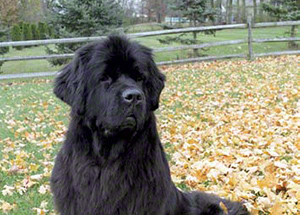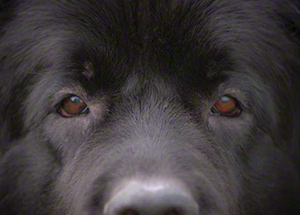Just as a clean Newf is not only healthier but more of a joy to its owner, so too, does proper trimming have benefits beyond appearance. Feet that look like dust mops don't work that way. They do, however, trap outdoor mud and magically release it on the carpet. Besides being harder to keep clean, shaggy feet provide an excellent environment for the development of fungus infections of the pads. Untrimmed ears also help foster the growth of fungus infections by reducing air circulation and trapping moisture.
Trimming can be done on the floor (don't try it on carpeting or your rug may develop some bare spots), but its a lot easier on your back if you have a low (24") grooming table on which to stand your dog. A grooming arm or friend to help keep the dog on the table is very helpful. Always remember a dog can move faster than you can and you will be working with sharp scissors. The equipment I suggest for basic trimming is a greyhound comb, a Universal slicker brush, a pair of 6-1/2" ball-tipped curved scissors and a pair of thinning shears (approx. 30 tooth--double edges preferred). Always start with a bathed, dried and brushed dog.
To trim a foot, stand your dog on the table. Pick up the foot and with the curve of the scissors pointing away, trim the hair on the bottom of the foot flush with the pads. Put the foot down on the table and brush the hair up between the toes. With the scissors pointing straight down and the curve towards the dog, trim the front and sides of the foot. Keeping the scissors along the line of the toes, trim the hair sticking up between the toes down to the level of the hair on the toes to make a rounded arch. Brush the foot again with the slicker and repeat trimming until no more extra hair comes up. Finally, for the front feet, point the scissors down with the curve towards the dog and trim the bottom of the feathers rounding them into the bottom of the foot to keep them from dragging on the ground.
To trim the hocks, comb the hair straight out all the way around. Stand the dog so the foot is positioned correctly (i.e., the hock is perpendicular to the table). Trim the sides of the hock vertically the width of the foot so they are parallel. Then trim the back of the hock vertically so it is parallel to the front. Round off the edges to make an oval hock. Then round the bottom into the foot at the same angle as the feathers were rounded on the front feet.
Comb the hair on the ear and use the scissors around the edge to trim the hair and define the shape. Then use the comb to lift the hair and the thinning shears to blend the length from short at the tip to round up to the length of the hair at the top of the head. Finally, lift up the ear and use the scissors to trim the long fuzzies under the ear to blend with the neck.
Don't be afraid to trim your Newf. If the end result doesn't look like what you wanted, remember you're dealing with one of natures great renewable resources and in a few weeks you'll have another chance to try your hand. Keep telling what a good looking guy (or girl) he is and regular trimmings can be fun for you and your dog.

